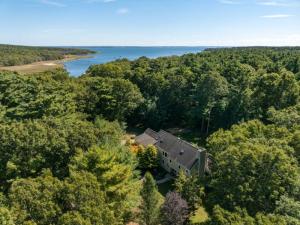Catch, record, conserve: The turtles in our waterways
 A volunteer from the New England Coastal Wildlife Alliance holds a female Diamondback Terrapin at Parkwood Beach in Wareham on Friday, June 27. The alliance usually catches, records and releases about 200 terrapins, a threatened species, a year.
A volunteer from the New England Coastal Wildlife Alliance holds a female Diamondback Terrapin at Parkwood Beach in Wareham on Friday, June 27. The alliance usually catches, records and releases about 200 terrapins, a threatened species, a year. Lara Schofield, right, a New England Coastal Wildlife Alliance volunteer, passes a turtle to the alliance’s Founder and President Carol “Krill” Carson, left, during a release of two Diamondback Terrapins behind Wareham High School.
Lara Schofield, right, a New England Coastal Wildlife Alliance volunteer, passes a turtle to the alliance’s Founder and President Carol “Krill” Carson, left, during a release of two Diamondback Terrapins behind Wareham High School. young Diamondback Terrapin is held before its release at Wareham High School. This turtle has grown up in an aquarium, giving it the strength of a three or four year old terrapin, but the brain development of a hatchling.
young Diamondback Terrapin is held before its release at Wareham High School. This turtle has grown up in an aquarium, giving it the strength of a three or four year old terrapin, but the brain development of a hatchling. Carol “Krill” Carson carefully digs into the sand near turtle tracks she saw near the baseball field at Wareham High School to check if eggs are present. Carson said the “neck” or top of the nest can be felt when there’s an empty cavity in the sand.
Carol “Krill” Carson carefully digs into the sand near turtle tracks she saw near the baseball field at Wareham High School to check if eggs are present. Carson said the “neck” or top of the nest can be felt when there’s an empty cavity in the sand. Kevin Kangiser, left, takes a photo of the 100th Diamondback Terrapin the team has caught this season, while Kerin Johnson, right, holds a measuring device over the underside of the turtle.
Kevin Kangiser, left, takes a photo of the 100th Diamondback Terrapin the team has caught this season, while Kerin Johnson, right, holds a measuring device over the underside of the turtle. A volunteer from the New England Coastal Wildlife Alliance holds a female Diamondback Terrapin at Parkwood Beach in Wareham on Friday, June 27. The alliance usually catches, records and releases about 200 terrapins, a threatened species, a year.
A volunteer from the New England Coastal Wildlife Alliance holds a female Diamondback Terrapin at Parkwood Beach in Wareham on Friday, June 27. The alliance usually catches, records and releases about 200 terrapins, a threatened species, a year. Lara Schofield, right, a New England Coastal Wildlife Alliance volunteer, passes a turtle to the alliance’s Founder and President Carol “Krill” Carson, left, during a release of two Diamondback Terrapins behind Wareham High School.
Lara Schofield, right, a New England Coastal Wildlife Alliance volunteer, passes a turtle to the alliance’s Founder and President Carol “Krill” Carson, left, during a release of two Diamondback Terrapins behind Wareham High School. young Diamondback Terrapin is held before its release at Wareham High School. This turtle has grown up in an aquarium, giving it the strength of a three or four year old terrapin, but the brain development of a hatchling.
young Diamondback Terrapin is held before its release at Wareham High School. This turtle has grown up in an aquarium, giving it the strength of a three or four year old terrapin, but the brain development of a hatchling. Carol “Krill” Carson carefully digs into the sand near turtle tracks she saw near the baseball field at Wareham High School to check if eggs are present. Carson said the “neck” or top of the nest can be felt when there’s an empty cavity in the sand.
Carol “Krill” Carson carefully digs into the sand near turtle tracks she saw near the baseball field at Wareham High School to check if eggs are present. Carson said the “neck” or top of the nest can be felt when there’s an empty cavity in the sand. Kevin Kangiser, left, takes a photo of the 100th Diamondback Terrapin the team has caught this season, while Kerin Johnson, right, holds a measuring device over the underside of the turtle.
Kevin Kangiser, left, takes a photo of the 100th Diamondback Terrapin the team has caught this season, while Kerin Johnson, right, holds a measuring device over the underside of the turtle.A swift waddle, a small trail of bubbles and the female Diamondback Terrapin was gone.
Ripples passed over the ridges of her armor-like plating as she swam away from Parkwood Beach.
This Diamondback Terrapin, a medium-sized turtle that dwells in the brackish waterways of coastal New England, was the 100th terrapin turtle this year the New England Coastal Wildlife Alliance has caught and logged for their extensive conservation work.
The alliance's goal with the turtles is to study and conserve their populations that live in the marshes of Marion, Mattapoisett, Pocasset and Wareham.
“Our motto is that every animal counts. If somebody calls me today about a snapping turtle, we respond, or an injured bird, dog or cat — I don’t care what it is — we want to rescue it,” said Carol “Krill” Carson, the founder and president of the New England Coastal Wildlife Alliance.
Carson, a Middleboro resident and whale biologist, said her team is now in the “turtle season”. The Diamondback Terrapins nest during the summer months, and their eggs hatch in August and September.
Her team of volunteers, many of them high school and college students, race around beaches and marshes across the South Coast to catch and collect data on the turtle population. Their data is used by researchers to support conservation and research efforts. They also save turtles and their nests from dangerous situations.
According to the Massachusetts State Fisheries and Wildlife Division, terrapins were nearly hunted to extinction in the early 1900s due to overharvesting for their use in gourmet food. Now, the state lists terrapins as a highly threatened species.
On Friday, June 27, Carson and two volunteers released two “head start” turtles into the marshes behind Wareham High School. These turtles have been raised in an aquarium and given all the food - and attention - they needed as they were cared for by a summer program at Wareham High School. The program, named SAIL, includes after school sessions and a summer program that offers classes in photography, fishing, art and more.
“We're doing something very unnatural. We're keeping them going. We're feeding them and keeping them active,” Carson said.
In the Fall, Carson’s team provides turtles to trained teachers in the community. Normally these turtles would “brummate”, or hibernate, during the winter months and later emerge in the spring. Instead, they are kept active and cared for by the teachers and their students. Although they still have the brain of a hatchling turtle, their bodies and strength are that of a turtle that is three or four years in age.
Carson said the program is mainly focused on educational outreach. In classrooms, students can have a hands-on learning experience with a threatened turtle species that lives in their neighborhood.
Once a pile of reeds and grass were placed on top to cover the turtles on the marsh's edge, that’s the last help they got from Carson and her team.
Carson then got a phone call from her team of college and high school volunteers out on the turtle-search at Parkwood Beach in Wareham.
At the beach, college students Kerin Johnson and Kevin Kangiser, Weymouth and Bridgewater residents respectively, were recording and tagging a 10-year-old female terrapin, the 100th terrapin that’s been caught and logged this season.
The team responded shortly after a Wareham resident called in a sighting. When they don’t get a call, teams are out patrolling popular turtle nesting spots and searching for hard-to-miss turtle tracks in the sand. The tracks either lead them to a nesting site, which the team would then protect with protective fencing, or a turtle itself.
“They're the most skittish turtle you ever saw,” Carson said.
At Parkwood Beach on Friday, Johnson and Kangiser checked to see if the turtle had been tagged before, they took photos and measurements, approximated the age and weighed it. Diamondback terrapins can have unique facial pigments that resemble mustaches. They also have unique shell abnormalities in the shell’s plate-like scales, called “scutes”.
“We try to see if they're gravid, or if they have eggs. It's kind of hard to tell, but you can feel the inside of the leg and feel if there's any swelling or eggs,” Kangiser said. When a female turtle is “gravid”, it has eggs ready to be laid.
During an average season, Carson said about 200 terrapins are caught and recorded. It changes every season depending on the amount of volunteers. More hands means more data and more turtles saved from dangerous situations.
Environmental pressures that threaten the South Coast's terrapin population include erosion, human development and rising sea levels. These pressures result in loss of their salt marsh habitat and nesting sites. The terrapins also have to navigate around residences, roadways and the fishing industry, said Carson.
The team has a lot of work ahead of them as the turtle hatching season overlaps with their other conservation efforts this Fall. Over August and September, hatchlings emerge while 800-pound Oceanic Sunfish and Torpedo Rays begin to be stranded on beaches and waterways.
The alliance also hosts educational outreach at schools and community events, often with a life-sized inflatable humpback whale to give youth a hands-on experience with the coastal environment.
Between the near constant turtle-sighting calls to Carson’s phone, and approaching almost every resident they see, the New England Coastal Wildlife Alliance strongly relies on the community for its volunteer base and field work.
“We're talking to everybody. Krill talks to everybody. Anybody and everybody that sees [us] out in the field, they're like, ‘you’re the turtle people. I know you. You are the turtle person!’” said Billie-Joe Gibbons, the intern and volunteer coordinator.
For more information on their conservation efforts and how to get involved, visit the New England Coastal Wildlife Alliance’s website. If a turtle is sighted or in danger, contact the alliance’s rescue phone-line at: 508-566-0009.






































